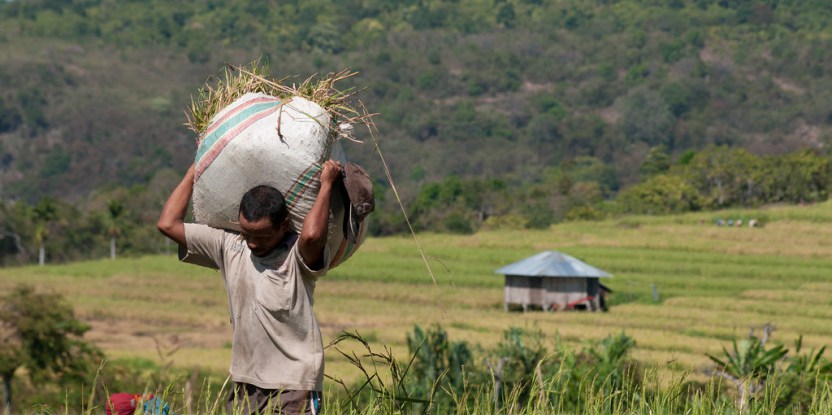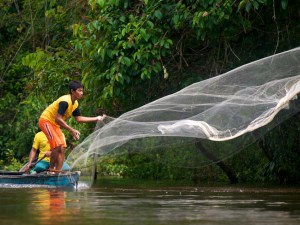
Editor’s Note: A version of this article was published previously by the International Institute for Environment and Development, here.
Since the 1980s, governments, donors and conservation and development organizations have spent vast sums on ‘alternative livelihoods’ projects that encourage people to cease an environmentally damaging activity in place of a sustainable one. But as there is a lack of evidence as to whether these projects work, a systematic study of the evidence is being conducted — and is seeking input.
Alternative livelihoods projects have been introduced in a variety of contexts: in Uganda to support gorilla conservation and in Afghanistan to reduce farmer’s dependence on poppy farming. They have encouraged people to farm seaweed instead of fishing, use fuel-efficient stoves as alternatives to traditional fires, and farm and eat cane rats in place of bushmeat.
Some developers of REDD+ projects, which aim to reduce carbons emissions from deforestation and forest degradation, have recognized the need to ensure local communities have alternative sources of income before implementing other aspects of the scheme, such as payments for protecting forests.
“Unless you offer a viable sustainable alternative livelihood,” said Erin Sills, senior associate at the Center for International Forestry Research (CIFOR) in 2011, “then any other intervention is really going to just displace or postpone deforestation.”
Variable results
At their best, alternative livelihoods projects have been hailed as a way to promote both conservation and development. The Missool ecotourism resort in Raja Ampat, Indonesia, is an example of a conservation and community engagement program. It employs around 120 local people, supports schools and has been instrumental in setting up a no-take fishing zone and a shark and manta ray sanctuary.
Many other projects are controversial. Practitioners share anecdotes of badly planned and unsuccessful interventions. Unsurprisingly, projects often create problems if they ignore the socioeconomic needs of people in potential conservation areas. For example, tribal communities relocated from Nagarhole National Park in India have long argued that their new livelihood options do not compensate them for the loss of their customary resources.
Where’s the evidence?
Despite all the money, effort and time invested, it’s debatable whether biodiversity conservation and poverty alleviation initiatives, including alternative livelihoods projects, are successful. There is little real evidence as to what has worked, what hasn’t and why.
This lack of evidence led the IUCN World Conservation Congress to pass a resolution last year calling for a critical review of the biodiversity benefits of alternative livelihood projects.
As a result, IIED has teamed up with CIFOR and the Zoological Society of London to undertake a systematic review of the evidence. A review the academic or gray literature (informally published material such as project reports) is being conducted to determine if there is evidence of alternative livelihood projects reducing threats to biodiversity. Results are due this summer.
To add to the confusion, these projects are described in a multitude of different ways: ‘Alternative livelihoods’, ‘income-generating activities’, ‘livelihoods support’, ‘livelihood diversification’, ‘livelihood switches’, ‘livelihood options’, and so on.
Organizations such as Fauna & Flora International have now moved away from using the term ‘alternative livelihoods’ and have adopted terms such as ‘livelihoods diversification’ or the ‘sustainable livelihoods approach’ to indicate a more holistic approach that better reflects the complexity of people’s lives and livelihoods.
Seeking your input
Do you think ‘alternative livelihood’ projects are an effective way to both reduce poverty and conserve biodiversity? Do you believe project implementers exaggerate success to satisfy donors? Can you think of an ‘alternative livelihood’ project that has been successful (or unsuccessful) in improving the conservation status of some element of biodiversity?
This could be, for example, a change in the conservation status of a species, a reduction (or not) in deforestation rates, or simply whether an environmentally degrading activity continued or ceased. If so, please e-mail relevant documents (such as project reports, journal articles, book chapters and so on) to m.day@cgiar.org or francesca.booker@iied.org.
The results will be shared in a follow-up blog this summer.
For more information about this topic, please contact Michael Day at m.day@cgiar.org or Terry Sunderland at t.sunderland@cgiar.org.
We want you to share Forests News content, which is licensed under Creative Commons Attribution-NonCommercial-ShareAlike 4.0 International (CC BY-NC-SA 4.0). This means you are free to redistribute our material for non-commercial purposes. All we ask is that you give Forests News appropriate credit and link to the original Forests News content, indicate if changes were made, and distribute your contributions under the same Creative Commons license. You must notify Forests News if you repost, reprint or reuse our materials by contacting forestsnews@cifor-icraf.org.
